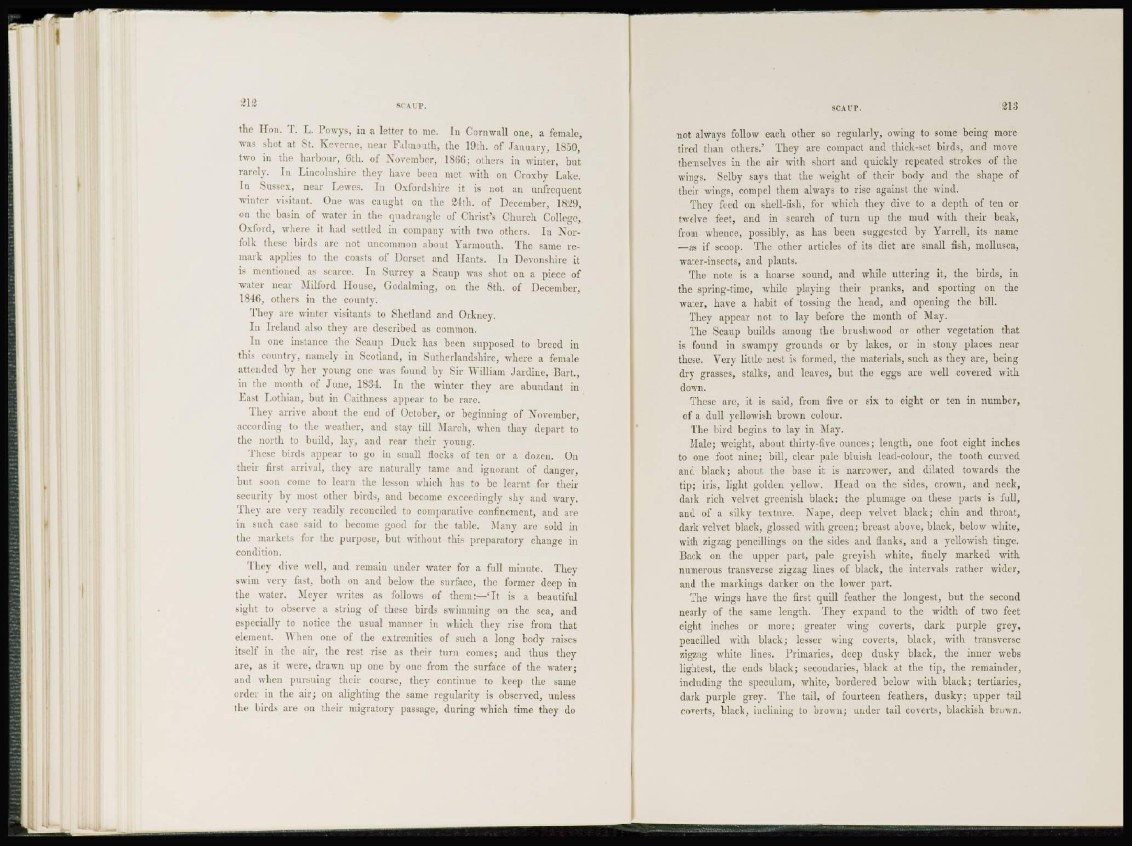
the Hon. T. L. Powys, in a letter to me. In Cornwall one, a female,
was shot at St. Kevcrne, near Falmouth, the 19:h. of January, 1850,
two in the harbour, 6th. of November, 1866; others in winter, but
rarely. In Lincolnshire they have been met with on Crosby Lake.
I n Sussex, near Lewes. In Oxfordshire it is not an unfrequent
winter visitant. One was caught on the 24th. of December, 1829,
on the basin of water in the quadrangle of Christ's Church College,
Oxford, where it had settled in company with two others. In Norfolk
these birds are not uncommon about Yarmouth. The same remark
applies to the coasts of Dorset and Hants. In Devonshire it
is mentioned as scarce. In Surrey a Scaup was shot on a piece of
water near Milford House, Godalming, on the 8th. of December,
1846, others in the county.
They are winter visitants to Shetland and Orkney.
In Ireland also they arc described as common.
I n one instance the Scaup Duck has been supposed to breed in
this country, namely in Scotland, in Sutherlandshire, where a female
attended by her young one was found by Sir William Jar dine, Bart.,
in the month of June, 1834. In the winter they are abundant in
East Lothian, but in Caithness appear to be rare.
They arrive about the end of October, or beginning of November,
according to the weather, and stay till March, when thay depart to
the north to build, lay, and rear their young.
These birds appear to go in small flocks of ten or a dozen. On
their first arrival, they are naturally tame and ignorant of danger,
but soon come to learn the lesson which has to be learnt for their
security by most other birds, and become exceedingly shy and wary.
They are very readily reconciled to comparative confinement, and are
in such case said to become good for the tabic. Many are sold in
the markets for the purpose, but without this preparatory change in
condition.
They dive well, and remain under water for a full minute. They
swim very fast, both on and below the surface, the former deep in
the water. Meyer writes as follows of them:—-'It is a beautiful
sight to observe a string of these birds swimming on the sea, and
especially to notice the usual manner in which they rise from that
element. "When one of the extremities of such a long body raises
itself in the air, the rest rise as their turn comes; and thus they
are, as it were, drawn up one by one from the surface of the water;
anil when pursuing their course, they continue to keep the same
order in the air; on alighting the same regularity is observed, unless
the birds are on their migratory passage, during which time they do
not always follow each other so regularly, owing to some being more
tired than others.' They arc compact and thick-set birds, and move
themselves in the air with short and quickly repeated strokes of the
wings. Selby says that the weight of their body and the shape of
their wings, compel them always to rise against the wind.
They feed on shell-fish, for which they dive to a depth of ten or
twelve feet, and in search of turn up the mud with their beak,
from whence, possibly, as has been suggested by Yarrell, its name
—as if scoop. The other articles of its diet are small fish, mollusca,
water-insects, and plants.
The note is a hoarse sound, and while uttering it, the birds, in
the spring-time, while playing their pranks, and sporting on the
water, have a habit of tossing the head, and opening the bill.
They appear not. to lay before the month of May.
The Scaup builds among the brushwood or other vegetation that
is found in swampy grounds or by lakes, or in stony places near
these. Very little nest is formed, the materials, such as they are, being
dry grasses, stalks, and leaves, but the eggs are well covered with
down.
These are, it is said, from five or six to eight or ten in number,
of a dull yellowish brown colour.
The bird begins to lay in May.
Male; weight, about thirty-five ounces; length, one foot eight inches
to one foot nine; bill, clear pale bluish lead-colour, the tooth curved
and black; about the base it is narrower, and dilated towards the
t i p ; iris, light golden yellow. Head on the sides, crown, and neck,
dark rich velvet greenish black: the plumage on these parts is full,
and of a silky texture. Nape, deep velvet black; chin and throat,
dark velvet black, glossed with green; breast above, black, below wdiite,
with zigzag pencillings on the sides and flanks, and a yellowish tinge.
Back on the upper part, pale greyish white, finely marked with
numerous transverse zigzag lines of black, the intervals rather wider,
and the markings darker on the lower part.
The wings have the first quill feather the longest, but the second
nearly of the same length. They expand to the width of two feet
eight inches or more; greater wing coverts, dark purple grey,
pencilled with black; lesser wing coverts, black, with transverse
zigzag white lines. Primaries, deep dusky black, the inner webs
lightest, the ends black; secondaries, black at the tip, the remainder,
including the speculum, wdiite, bordered below with black; tertlarics,
dark purple grey. The tail, of fourteen feathers, dusky; upper tail
coverts, black, inclining Lo brown; under tail coverts, blackish brown.